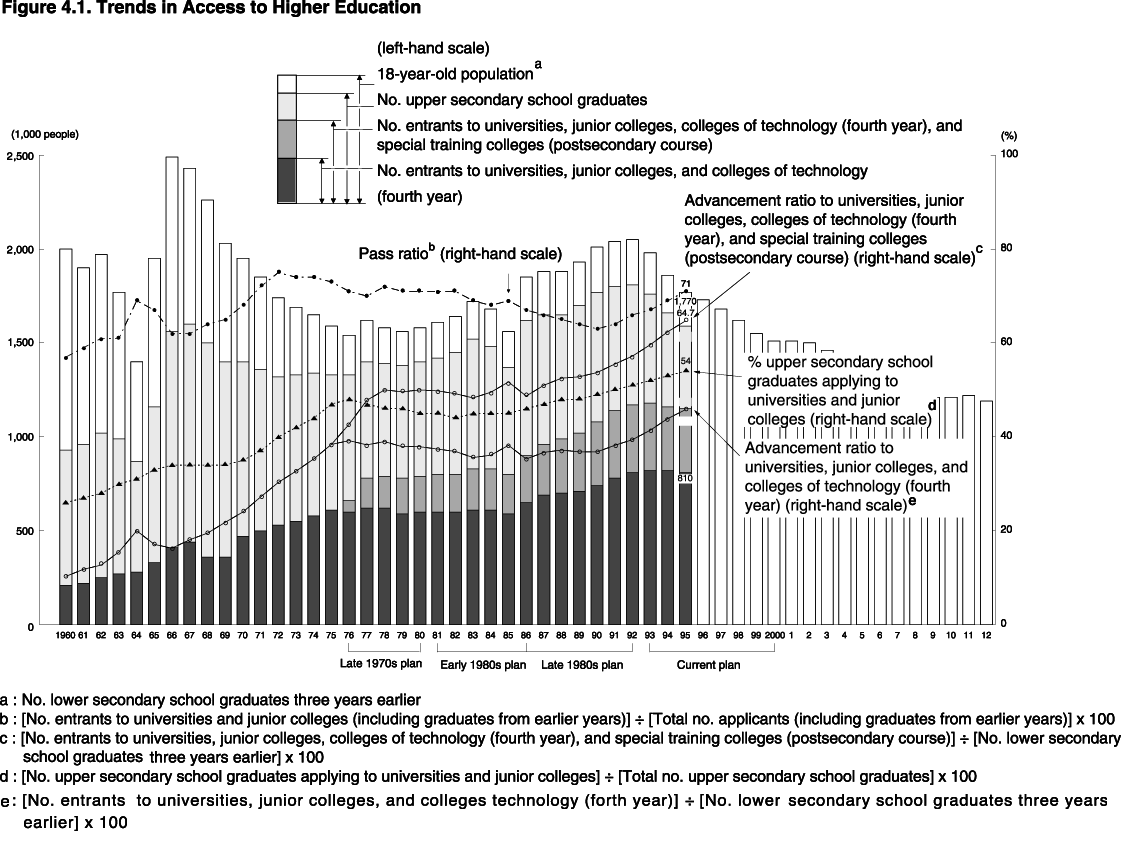| Home > Policy > White Paper, Notice, Announcement > White Paper > JAPANESE GOVERMENT POLICIES IN EDUCATION, SCIENCE, SPORTS AND CULTURE 1995 > Remaking Universities Chapter 4 Section 1 1 | ||
1. Higher education planning, 1975-86
:The quantitative improvement of postwar higher education was achieved through plans to attract more science and engineering students in the late 1950s and early 1960s and through measures to accommodate the baby-boom generation in the late 1960s and early 1970s. Public demand for higher education continued to expand, however, due to such factors as the growing number of students entering upper secondary schools and industry 's increasing demand for human resources. In 1975 the number of people entering universities, junior colleges, and colleges of technology (fourth year) reached 610,000, and the advancement ratio climbed to 38.4%. This rapid quantitative expansion created two problems. First, educational conditions deteriorated, as indicated by criticism of "mass-produced education." Second, the excessive concentration of universities in major cities was paralleled by regional imbalances in access to higher education.
The Government sought to remedy these problems through the systematic improvement of higher education under the late 1970s plan, based on a report of the Consultative Committee on Higher Education, and the early 1980s plan, based on a report of the University Chartering Council. During the period covered by these plans the 18-year-old population remained in the 1.5 million-1.6 million range.
The aim of both plans was to improve educational and research conditions by curbing quantitative expansion, alleviating excess enrollment in private universities, and other means. Efforts were also made to enhance higher education by improving the regional distribution of institutions of higher education by means of measures to restrain the establishment or expansion of universities in major cities.
2. Higher education planning after 1986
:The 18-year-old population continued to rise after fiscal 1986, peaking at 2.05 million in fiscal 1992, and then began to decline. It is expected to drop dramatically from now on, falling to 1.51 million in fiscal 2000. Focusing on the period of rapid growth in the 18-year-old population (fiscal 1986-92), the University Chartering Council produced a report titled "Planned Improvement of Higher Education Beginning in Fiscal 1986" (the late 1980s plan). Planning for the present period of rapid decline in the 18-year-old population is covered in a report by the University Council titled "Planned Improvement of Higher Education Beginning in Fiscal 1993" (the current plan). This plan covers the fiscal 1993-2000 period.
The late 1980s plan targeted the qualitative improvement of higher education and took account of the imbalance in regional distribution. It also focused on the quantitative expansion of higher education and sought to increase the admission quotas of universities, junior colleges, and colleges of technology in order to provide admission opportunities for a fast-rising 18-year-old population. In view of the onset of a rapid decline in the 18-year-old population in fiscal 1993, it was decided to make the increased admission quotas subject in part to time limits.
Under the current plan the emphasis is on qualitative improvement rather than quantitative expansion, and it is recognized that there is a need to curb the establishment and expansion of universities and other institutions of higher education. The implementation of these plans has brought about a gradual alleviation of regional imbalances in the distribution of institutions of higher education. Efforts are also being made to achieve the qualitative improvement of higher education. In addition, many faculties and departments have been established or expanded in fields in which there is a strong demand for human-resource development, such as information, social welfare, and medical technology.
The 18-year-old population peaked in fiscal 1992 and is expected to fall to 1.51 million in fiscal 2000 and 1.21 million in fiscal 2010. In fiscal 1995 the percentage of upper secondary school graduates applying to universities and junior colleges was 54.2%, while the advancement ratio to higher education, including colleges of technology (fourth year), was 45.8%. If professional training colleges (postsecondary course) are included, the percentage rises to 64.7%. These ratios have risen rapidly in recent years, and forecasts based on these trends indicate that the percentage of upper secondary school graduates wishing to advance to higher education and the advancement ratio will continue to rise in the future, taking Japan further along the path toward the popularization of higher education than most other countries ( Figure 4.1 ).
The spread of higher education has been accompanied by major changes in the environment of higher education. The growing need for lifelong learning can be expected to lead to further diversification of the student body and education delivery systems, while internationalization and the shift to an information-oriented society are likely to necessitate significant reforms in the approach to education and research at universities and other institutions. It has become necessary to give careful consideration to a vision for higher education in the next century. That vision must take into account the spread of higher education and the likelihood of dramatic social and economic change, as well as trends in various fields of learning. The University Council is carrying out wide-ranging deliberations on this future vision from the following perspectives.

| Back to Top | MEXT HOME |